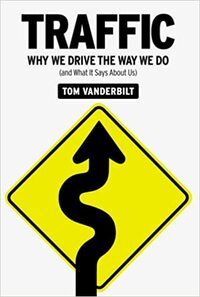Take a photo of a barcode or cover
Apasionante recorrido introductorio por la ingeniería del tráfico, desde la forma óptima que deben tener las intersecciones hasta cuánto se deben espaciar las incorporaciones, y un montón de curiosidades como el origen de los atascos fantasma (te paras, te paras, y de repente todos los coches de la carretera echan a andar sin que veas la causa del parón) y mil cosas interesantes más. Para los que hemos sentido curiosidad alguna vez, este libro intenta dar respuesta a todas nuestras preguntas. Me encantó.
Really interesting look at how we drive with explanations to questions like "why do traffic jams happen" and "how to 800 limos make it to the Oscars on time through the streets of LA." This book is another look into what drives our behavior and is a worthy read.
A very interesting book about traffic and driving that is full of great information that tries to explain traffic, a much more difficult subject than it first appears. The author boils down much research into a readable look at a myriad of issues relating to traffic, from the individual driver, to traffic engineers, to counterintuitive measurements that show how traffic works. Discussing how higher seating positions resulting in poorer perception of speed, how the more difficult a street is to navigate leading to a lower crash and fatality rate than the safer roads, how our perceptions make it seem that the other lane is always going faster, and much more. There was a lot of great information presented in this highly readable pop-science book.
This was really interesting .. if you're a traffic/driving/highway nerd (reminded me a bit of how everyone geeked out over highways in Microserfs). It felt a little long. And a bit repetitive. I never know if that's reading on a Kindle or the book :) There were some interesting topics (why things that are supposed to make us safer make us poorer/riskier drivers, driving in different cultures). A tighter edit would have improved, I think.
I did find it easy to read and enjoyable .. but I did have to push myself a couple of times to keep going.
I did find it easy to read and enjoyable .. but I did have to push myself a couple of times to keep going.
clever writing but i will agree with the other reviewers that said this should be a shorter book and feels a little stuffed with facts that I was interested in the beginning but became monotonous as the book progressed. I read the first 100 or so and skimmed the rest, but it is that kind of book.
This got into my head a little bit. I'd like to see a google maps-era afterword and a covid-era afterword.
This book is beyond fascinating, and one of the most interesting things I have *ever* read. (And no, I don't think it's just because I recently had a nearly life-ending car accident.) Every chapter, every page, discusses some research or insight into how people drive, how traffic works (or doesn't work), how when where and why accidents happen, etc. The most interesting chapters for me were: "How Our Eyes and Mind Betray Us on the Road," about the limits of what we see, or think we see, and how we process it while driving; "When Dangerous Roads Are Safer," about the seemingly paradoxical relationship between a road's perceived and actual safety; and "Driving with a Local Accent," on the differences in traffic as reflections of culture. (From this last chapter, for example, it turns out that a country's rate of corruption is directly proportional to its rate of accident violations and fatalities.) I'd recommend this book to everyone who drives, because driving is such a large, yet still largely mysterious, part of our lives.
Lots of interesting tidbits in this book that certainly make me terrified to drive. However, could have been 100 pages instead of 300 and that would have been okay with me.
Just far too long of a book on the topic. 3 chapters in I was already burnt out on un-tested hypotheses.






